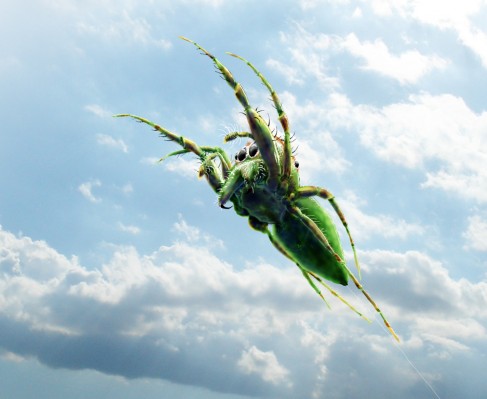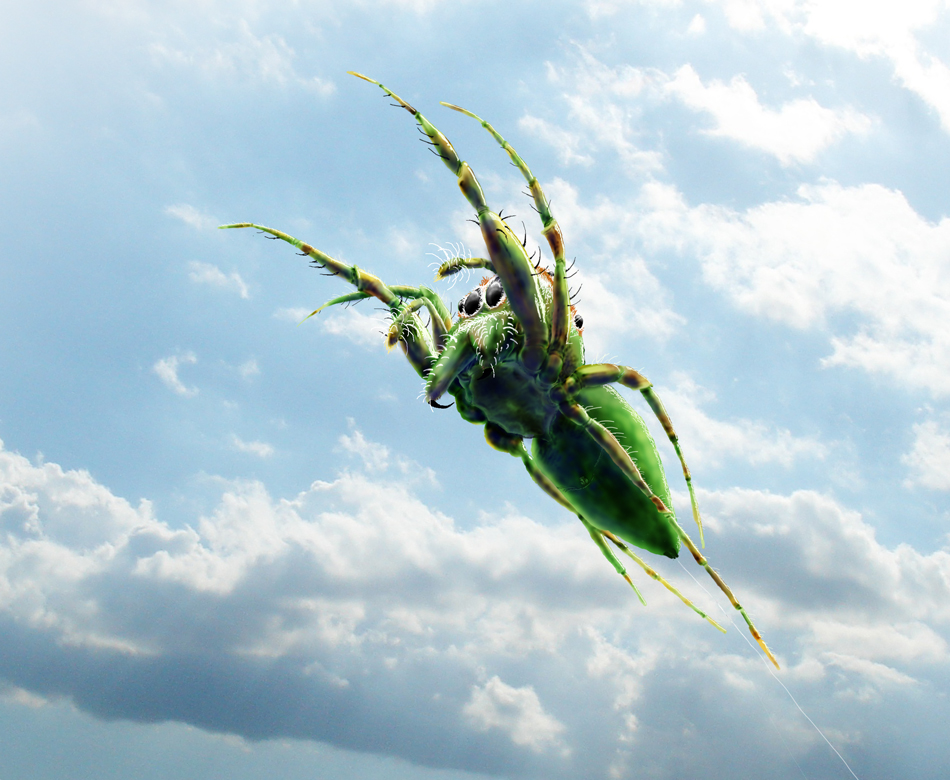 I did this image of a salticid, (also known as a jumping spider), in mid flight. What is coolest about it is that it is from a vantage point that you could never really photograph. They are one of the many cool spiders that DO NOT make webs to catch prey, but are inquisitive, extremely intelligent, active hunters that launch themselves airborne onto their unsuspecting prey.
I did this image of a salticid, (also known as a jumping spider), in mid flight. What is coolest about it is that it is from a vantage point that you could never really photograph. They are one of the many cool spiders that DO NOT make webs to catch prey, but are inquisitive, extremely intelligent, active hunters that launch themselves airborne onto their unsuspecting prey.
Don’t get me wrong, I love my web-bound spiders. But that they normally rely on vibrations and not visual cues means that evolution has dealt them a hand of very poor vision. Salticids, at the opposite end of the spectrum, have evolved one of their pairs of “median” eyes to become greatly enlarged, so they have incredible vision. While jumping spiders cannot move their whole eyes independently, they can move the retinas of their Anterior Median eyes. They cannot focus, but their movable retinas increase their field of vision.
They are also known for their deft ability to learn and solve problems in approaching prey. Often in search of the best angle to approach their unsuspecting prey, salticids, (specifically Portias) have been observed taking such far flung routes to reach the prey that they break visual contact with it! check out this wikipedia description on Portias: http://en.wikipedia.org/wiki/Portia_%28genus%29
In making this illustration, the most difficult part was figuring out the posture of the legs. You can imagine how impossible it is to observe a jumping spider in mid-flight…just watching one move from place to place, it happens so fast you never even see the inbetween, just poof! and its on the next leaf. I am lucky enough to have captured a partial stereo image of a jumping spider jumping toward the lens bracket of my macro camera! So I was able to use it, and other generalized illustrations, like in Rainier Foelix’s book on spiders, to come up with this illustration. I loved doing it, and hope to illustrate many more salticids.


nice photo of spider there…i am not aware of the existence of this creature until you show it to your post..congratulations! you did an excellent job..
its not a photo but an illustration. Jumping spiders are all around you and the coolest spiders out there- get down on your hands and knees and take a look!
. Thanks for your post
Sorry, but you got something wrong: Jumping spiders cannot move their EYES independently, but only their retinas (and only of the Anterior Median Eyes).
More importantly, they cannot focus. The movable retinas simply increase the field of vision.
It is an honor to receive an email from you, even if it is to correct my blatant errors.
I own your book on spiders and absolutely love it, but should have fact checked first. I will make some corrections.
I am in indonesia now, and while I don’t have a good macro camera, I have been checking out the spiders and for the first time in my life finally got to observe 2 different ant-mimicking salticids in the jungle. so so amazing.
Hope you are well, I really appreciate you posting to me.
As you know I am an illustrator, and I have my arachnid portrait paintings I plan to do in the near future…I will keep you posted!
Dear Marlin,
wow, you are quick – you already made the change!
One more thing: it is possible to have multiple pictures of a leaping jumping spider by using a strobe light. David Hill from South Carolina has magnificent shots and I used two of his sequences in the last edition of my book. Do you have the 3rd ed. (2011) – it is on p. 196/197
best, Rainer
PS: you may want to check out “David Hill Peckhamia ” on the internet to see some outstanding salticid pictures and articles